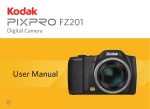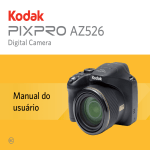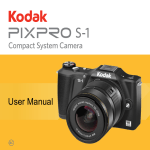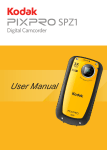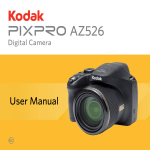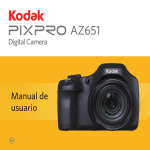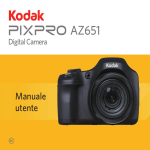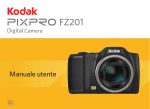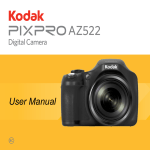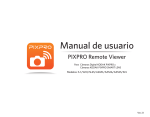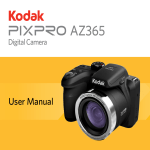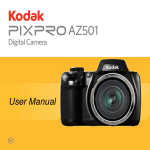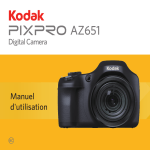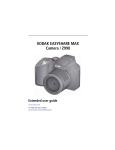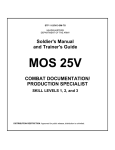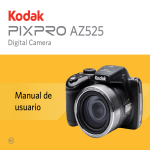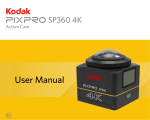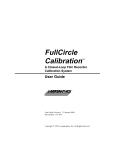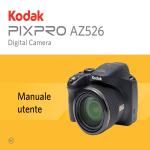Download User Manual - kodakpixpro.com
Transcript
User Manual BEFORE YOU START Declaration of Conformity Responsible Party: JK Imaging Ltd. Address: JK Imaging Ltd., 17239 South Main Street, Gardena, CA 90248, USA JK Imaging Europe, 71 Clarendon road, Watford, WD17 1DS, UK Company Website: www.kodakpixpro.com INDUSTRY CANADA This device complies with Canadian RSS-210. This device complies with Industry Canada license-exempt RSS standard (s).Operation is subject to the following two conditions: (1) this device may not cause interference, and (2) this device must accept any interference, including interference that may cause undesired operation of the device. Radiation Exposure Statement: This product complies with the Canadian portable RF exposure limit set forth for an uncontrolled environment and is safe for intended operation as described in this manual. Additional RF exposure reduction can be achieved if the product can be kept as far as possible from the user body or set the device to lower output power if such function is available. 1 For Customers in Europe This symbol [crossed-out wheel bin WEEE Annex IV] indicates separate collection of electrical waste and electronic equipment in the European countries. Please do not throw the equipment into domestic refuse. Please use the return and collection systems available in your country for proper, safe disposal of this product. “CE” mark indicates that this product complies with the European requirements for safety, health, environment and customer protection. “CE” marked cameras are intended for sales in Europe. Europe – EU Declaration of Conformity This device complies with the essential requirements of the R&TTE Directive 1999/5/EC. The following test methods have been applied in order to prove presumption of conformity with the essential requirements of the R&TTE Directive 1999/5/EC: - EN 60950-1: 2006+A11:2009 +A1:2010 +A12:2011 Safety of Information Technology Equipment - EN 50566: 2013 Product standard to demonstrate compliance of radio frequency fields from handheld and body- mounted wireless communication devices used by the general public (30 MHz — 6 GHz) - EN 62209-2: 2010 Human exposure to radio frequency fields from handheld and bodymounted wireless communication devices — Human models, instrumentation, and procedures 2 Part 2: Procedure to determine the specific absorption rate (SAR) for wireless communication devices used in close proximity to the human body (frequency range of 30 MHz to 6 GHz) - EN 300 328 V1.8.1 : 2012 Electromagnetic compatibility and Radio spectrum Matters (ERM); Wideband Transmission systems; Data transmission equipment operating in the 2.4 GHz ISM band and using spread spectrum modulation techniques; Harmonized EN covering essential requirements under article 3.2 of the R&TTE Directive. - EN 301 489-1 V1.9.2: 2011 Electromagnetic compatibility and Radio Spectrum Matters (ERM); Electro Magnetic Compatibility (EMC) standard for radio equipment and services; Part 1: Common technical requirements. - EN 301 489-17 V2.2.1:2012 Electromagnetic compatibility and Radio spectrum Matters (ERM); Electro Magnetic Compatibility (EMC) standard for radio equipment and services; Part 17: Specific conditions for 2.4 GHz wideband transmission systems and 5 GHz high performance RLAN equipment. For Customers in the U.S.A. Federal Communication Commission Interference Statement This device complies with Part 15 of the FCC Rules. Operation is subject to the following two conditions: (1) This device may not cause harmful interference, and (2) this device must accept any interference received, including interference that may cause undesired operation. 3 This equipment has been tested and found to comply with the limits for a Class B digital device, pursuant to Part 15 of the FCC Rules. These limits are designed to provide reasonable protection against harmful interference in a residential installation. This equipment generates, uses and can radiate radio frequency energy and, if not installed and used in accordance with the instructions, may cause harmful interference to radio communications. However, there is no guarantee that interference will not occur in a particular installation. If this equipment does cause harmful interference to radio or television reception, which can be determined by turning the equipment off and on, the user is encouraged to try to correct the interference by one of the following measures: - Reorient or relocate the receiving antenna. - Increase the separation between the equipment and receiver. - Connect the equipment into an outlet on a circuit different from that to which the receiver is connected. - Consult the dealer or an experienced radio/TV technician for help. FCC Caution: Any changes or modifications not expressly approved by the party responsible for compliance could void the user’s authority to operate this equipment. This transmitter must not be co-located or operating in conjunction with any other antenna or transmitter. Radiation Exposure Statement: This product complies with the FCC portable RF exposure limit set forth for an uncontrolled environment and is safe for intended operation as described in this manual. Additional RF exposure reduction can be achieved if the product can be kept as far as possible from the user body or set the device to lower output power if such function is available. 4 About this Manual Thank you for purchasing this KODAK PIXPRO Digital Camera. Please read this manual carefully and keep it in a safe place for future reference. JK Imaging Ltd. reserves all rights of this document. No part of this published manual may be reproduced, transmitted, transcribed, stored in a retrieval system or translated into any language or computer language, in any form, by any means, without the prior written permission of JK Imaging Ltd.. All trademarks mentioned in this manual are used for identification purposes only and are properties of their respective owners. This manual will instruct you on how to operate the KODAK PIXPRO Digital Camera. JK Imaging Ltd. has tried its utmost to ensure the correctness of the user manual contents, but reserves the right to modify as necessary. All of these contents are subject to change without prior notice. Throughout this manual, the following symbols are used to help you locate information quickly and easily: Indicates useful information. Indicates precautions are to be taken while operating the camera. In the instructions below, the following symbols may be used throughout this manual on how to operate the camera. This is to facilitate better understanding. 「Item properties」: The optional properties in the camera interface are indicated by the symbol「 」. 5 SAFETY NOTES Safety notes for this camera Do not drop the camera or allow it to hit solid objects. Do not attempt to disassemble or repair the camera. Do not use or store the camera in dusty places or on a beach to prevent dust or sand from entering the camera, causing possible damage to it. Do not use or store the camera in a hot environment or under direct sunlight. Do not use or store the camera near a powerful magnetic field, for example near a magnet or transformer. Avoid touching the lens of the camera. Do not expose the camera to direct sunlight for a long period of time. To prevent the camera from being damaged by moisture, do not use or store the camera in very humid environments, such as in rain or near bodies of water. If water accidentally comes in contact with the camera, turn the camera off, remove the battery and the memory card, and dry it within 24 hours. 6 When you take the camera from a cold place to a warmer environment, condensation may occur. Please wait for a reasonable period of time before you turn it on. Before you remove the battery and memory card, the camera should be turned off. When you clean the body of the camera, do not use abrasive, alcohol-based or organic cleaner. Use a professional lens wiping cloth and dedicated cleaner to wipe and clean the lens. Download your photos and remove the memory card when you are going to store the camera for a long period of time. If this camera is not in use for a long time, please keep it in a dry and clean condition. Our company will not pay compensation for any failure of playback of pictures or videos caused by improper operation. Safety notes for battery Please use a battery that is the same type as the one included. Do not heat the battery or throw it into a fire to avoid a possible explosion. Please use the attached charger to charge the battery. Do not store the battery in a hot environment or in direct sunlight. If battery fluid leaks inside the camera, contact our customer service department. If battery fluid leaks onto your skin, rinse your skin with clean water and seek immediate medical attention. If the battery overheats during charging or use, stop charging or use immediately. Turn off the product, remove the battery carefully, and wait until it cools down. Disposal of used batteries should be carried out in accordance with the local (national or regional) regulations. To prevent the battery from being damaged, do not drop the battery or allow it to hit solid objects or to be scratched by the objects. Do not let the battery come in contact with metal objects (including coins) to avoid short circuiting, discharging, excessive heat, or possible leakage. When the camera is stored for a long period of time, remove the battery and keep it in a dry place that is not accessible to infants and children. In a colder environment, the performance of the battery could be noticeably reduced. When you install the battery, install it according to the positive and negative markings on the battery compartment. Never force it into the battery compartment. Do not attempt to disassemble the battery. Do not expose the battery to water. Always keep the battery contacts dry. 7 Safety notes for memory card We suggest buying only well-known, name brand memory cards to ensure peak performance. Format the memory card using the camera before you use it or insert a new one. Do not drop the memory card or allow it to hit solid objects to avoid damaging it. Do not attempt to disassemble or repair the memory card. Do not expose the memory card to water. Always keep it dry. Do not remove the memory card when the camera is turned on. Otherwise, the memory card could be damaged. Do not directly edit the data on the memory card. Copy the data to your PC before you edit them. When the camera is stored for a long period of time, be sure to download your photos and remove the memory card. Store it in a dry environment. 8 Do not modify the name of the files or folders of the memory card using your PC. Modifying the file names may cause the files to not be recognized on the camera or a possible error may occur. A photo taken with the camera will be stored in the folder that is automatically generated on the memory card. Do not store photos that are not taken using this camera in these folders as the pictures cannot be recognized during the playback. When you insert a memory card, make sure the notch of the card matches the markings on the top of the card slot. Other Safety Notes Do not disconnect the power or turn the camera off during the update process. Doing so may cause incorrect data to be written and the camera may not power on later. Do not hang the neck strap of the camera around the neck of a child. When using your camera on an airplane, observe the relevant rules specified by the airline. Due to the limitations of manufacturing technology, the LCD may have a few dead or bright pixels. These pixels do no effect the quality or performance of the camera, photos or video. Do not expose the LCD to water. In a humid environment, only wipe it with a soft and dry cleaning cloth. If the LCD is damaged and the liquid crystal comes into contact with your skin, wipe your skin with a dry cloth immediately and rinse it with clean water. If liquid crystal comes into contact with your eyes, wash them with clean water at least for 15 minutes and seek immediate medical attention. If you accidentally swallow liquid crystal, rinse your mouth immediately and seek medical attention. 9 CONTENTS BEFORE YOU START......................1 SAFETY NOTES...............................6 CONTENTS..................................... 10 GETTING READY.......................... 14 Accessories Included................................... 14 10 MODE OVERVIEW.......................27 LCD Display................................................... 27 Overview of the Screen Icons in Shooting Mode.......................................27 Overview of the Screen Icons in Movie Mode...........................................29 Overview of the Screen Icons in Playback Mode.......................................30 Install lens cap and neck strap.................. 15 How to take pictures.................................... 31 Part Names.................................................... 16 Using the Mode Dial.................................... 32 Installing Battery and Memory Card........ 19 Face Beautifier........................................35 Charging Battery.......................................... 21 Wi-Fi Mode.............................................36 Vari-angle LCD.............................................. 22 Scene Mode............................................43 Turning Camera On and Off....................... 23 Custom Settings....................................49 Set your Language, Date/Time................. 24 BASIC OPERATION.......................51 Set your Language, Date/Time after the first power-on........................24 Using EVF (Electronic View Finder)......... 51 Resetting your Language......................25 Using the Zoom Function............................ 52 Resetting Date/Time............................26 Display Setting.............................................. 53 AF Area........................................................... 55 Macro Mode.................................................. 56 Self-timer Mode ........................................... 57 Flash Mode ................................................... 58 PLAYBACK......................................71 Viewing Photos and Videos........................ 71 Thumbnail View............................................ 72 WB (White Balance) Mode ....................... 60 Using Zoom Playback (for still pictures only)................................................................ 73 Continuous Shot Mode............................... 62 Continuous Shot Group Playback............. 74 Exposure Compensation Functions Setting............................................................. 64 Animation panorama play.......................... 75 EV Adjustment.......................................64 Slideshow....................................................... 76 Photos and Video Deletion......................... 77 ISO Adjustment.....................................65 Shutter Speed Adjustment..................65 USING THE MENUS.....................78 Aperture Adjustment...........................66 Shooting Menu.............................................. 78 Using Quick Recording................................ 66 Expo Metering........................................79 i Button Function Menu............................... 67 OIS (Optical Image Stabilization)......79 Using the Lens Function Ring..................... 68 Beautifier.................................................80 Zoom/AF Mode.....................................68 Select Scene............................................80 Function Ring (Smart) Mode..............69 MF(Manual Focus) Mode....................70 Shoot Setting1............................................... 81 Image Size...............................................82 11 12 Movie Size...............................................83 Touch-up..................................................96 Quality.....................................................84 Resize.......................................................97 MF (Manual Focus) Assist..................85 Playback Settings ........................................ 97 AF Assist Beam......................................86 Protect......................................................98 Digital Zoom...........................................86 Delete.......................................................98 Shoot Setting 2.............................................. 87 DPOF (Digital Print Order Format)....99 Date Imprint...........................................88 Trim........................................................ 100 Quick Review..........................................88 Play Slide Show................................... 100 Cont. AF...................................................89 General Settings......................................... 101 Face Detection.......................................89 Sound Settings.................................... 102 Custom Settings....................................90 Power Saver......................................... 102 Function Ring (Smart)..........................91 Language.............................................. 103 Playback Menu............................................. 92 World Time.......................................... 103 Menu........................................................92 Date & Time......................................... 103 Display Mode.........................................93 LCD Brightness.................................... 103 Rotate.......................................................93 File Settings................................................. 104 Color.........................................................94 Format .................................................. 105 HDR..........................................................95 Copy to Card........................................ 106 File Numbering.................................... 106 Video System.............................................. 116 Reset Settings...................................... 107 Supported HDMI Connections................ 117 Version.................................................. 107 Connecting HDMI-Ready TV........... 117 CONNECTION SETTINGS.........108 HDMI CEC Control..................................... 118 Set Eye-Fi SD Card Connection Mode.... 123 Connecting to a Computer....................... 108 Setting the USB Mode....................... 108 APPENDICES................................124 Transferring files to your computer....109 Product Specifications............................... 124 Connecting to a PictBridge Compatible Printer........................................................... 110 Prompts and Warning Messages............ 129 Troubleshooting.......................................... 134 Setting the USB Mode....................... 110 Connecting to your Printer............... 111 Using the PictBridge Menu....................... 112 Print (with Date)................................. 112 Print (without Date)........................... 113 Print Index............................................ 114 Print DPOF Images............................. 115 Exit......................................................... 115 13 GETTING READY Accessories Included Your camera box should contain the camera model you purchased along with the following accessories. If anything is missing or appears to be damaged, please contact your retailer.(Based on sales in different countries or regions, the shape of the AC adapter will vary. Please subject to the actual product will prevail.) Rechargeable Li-ion battery Quick St AC adapter art Gui Neck strap Lens cap with strap STOP de Quick start guide 14 Micro USB cable Warranty card Service card CD-ROM Install lens cap and neck strap 15 Part Names 4 5 6 7 8 9 1. Micro HDMI Port 10 2. Micro USB Port 3. Zoom Lever 11 4. Shutter Button 5. Strap Eyelet 3 2 1 6. Exposure Compensation Button 7. Continuous Shot Button 8.Power Button 9. AF Assist Beam/Self-timer Lamp 10. Flash Lamp 11. Lens 16 5 12 13 14 15 16 17 18 19 23 22 21 20 Rolling the 12. 13. 14. 15. 16. 17. 18. 19. Microphone Electronic View Finder (EVF) EVF / LCD Switch Button Indicator Lamp Mode Dial Fast Video Recording Button Menu Button Jog Dial [ ] AF Button/Up Button [ ] Delete Button/Self-timer Button/Down Button [ ] Macro Button/Left Button [ ] Flash Button/Right Button 20. Display Button 21 . Playback Button 22. SET Button 23. i Button jog dial can be for fast selection instead of pressing the up/down/left/right button. 17 24. Vari-angle LCD 25.Speaker 26. Lens Function Ring Lever 27. Lens Function Ring 27 26 25 24 28. Battery Cover 29. Tripod Socket 29 18 28 Installing Battery and Memory Card 1. Open the battery cover. 1 2 2. Insert the battery into the battery compartment according to the negative and positive directions as illustrated in the picture. Push the battery down until it locks in place. Battery lock knob 19 3. Insert the memory card into the memory card slot as shown in the diagram. 4. Close the battery cover. 1 2 Write protection buckle The memory card (SD/SDHC) is optional and not included in all camera packaging. If you have to purchase a memory card, select one with storage capacity between 4GB and 32GB to ensure correct data storage. To remove your memory card, open the battery cover, gently press the memory card to eject it and remove it carefully. 20 Charging Battery Please insert the battery and charge it under shutdown mode. 1. Connect the camera and the power charger using the supplied Micro USB cable. 2. Insert the plug of the power charger into the power outlet to charge the battery. 2 After the battery is stored for a long period of time, use the supplied power charger to charge the battery prior to use. Charging indicator: Steady orange: Charging Steady green: Charging complete To have maximum battery life, charge the battery for at least 4 hours the first time. 1 Indicator lamp Please charge the battery indoors between 0°C and 40°C. 21 Vari-angle LCD The LCD is housed in the camera’s body. You may follow the directions shown below to move it as needed: 2 3 1 4 1. Turn on the LCD along the direction shown by arrow ①. 2. Available to rotate 180° along the direction shown by arrow ②. 3. Available to rotate 90° along the direction shown by arrow ③. 4. Turn off the LCD along the direction shown by arrow ④. Please don’t rotate the LCD with excessive force to prevent damages. Please turn off the LCD along the direction shown by arrow ④ after use to protect it from scratches. 22 Turning Camera On and Off Press the power button to turn the camera on. To turn the camera off, press the power button again. Power Button When the power is off, press and hold the button to power on and enter playback mode. 23 Set your Language, Date/Time Set your Language, Date/Time after the first power-on 1. When you turn the camera on for the first time, the language selection screen appears. 2. Press the [ ]/[ ] button to select your desired language. 3. After you press the button to confirm the selection, the Date/Time settings screen appears. Language Sound Settings য檥Иކ Power Saver Powe Auto এѽИކ Language Langu English nglish মୁ World Time Home 㷼ᄙⱥ Date & Time 2014.04.23 00:00 English LCD Brightness B Français Select Se 4. Press the [ ]/[ ] button to select the Date/Time to be adjusted: Time is displayed in YYYY.MM.DD HH:MM. Set Exit Date & Time H-M 5. Press the [ ]/[ ] button to adjust the value for the selected Date/ Time. 6. Press the button to confirm the time settings and the shooting screen appears. Select 24 Set Exit Resetting your Language After you set your language for the first time, follow the instructions below to reset your language. 1. Press the button, press the [ ]/ [ ] button to select , and press the button to enter the menu. 2. Press the [ . ]/[ ] button to select 3. Press the [ ]/[ ] button to select「Language」and press the button to enter the menu. 4. Press the [ ]/[ ] button to select your desired language and press the button to confirm. 5. Press the button and the shooting screen appears. Sound Settings Power Saver Auto Language English World Time Home Date & Time 2014.04.23 00:00 LCD Brightness Select Set Exit Language Sound Settings য檥Иކ Power Saver Powe Auto এѽИކ Langu Language nglish English মୁ World Time Home 㷼ᄙⱥ Date & Time 2014.04.23 00:00 English B LCD Brightness Français Select Se Set Exit 25 Resetting Date/Time After you set your Date/Time for the first time, follow the instructions below to reset date and time. 1. Press the button, press the [ ]/ [ ] button to select , and press the button to enter the menu. 2. Press the [ . ]/[ ] button to select 3. Press the [ ]/[ ] button to select「Date & Time」and press the button to enter the menu. Sound Settings Power Saver World Time Home 2014.04.23 00:00 LCD Brightness Select Set Exit Date & Time H-M 5. Press the [ ]/[ ] button to press the value for your selected block. After you finish your settings, press the button to confirm. 26 English Date & Time 4. Press the [ ]/[ ] button to select the Date/Time to be adjusted: Time is displayed in YYYY.MM.DD HH:MM. 6. Press the button and the shooting screen appears. Auto Language Select Set Exit MODE OVERVIEW LCD Display Overview of the Screen Icons in Shooting Mode 1 2 34 5 6 7 8 9 10 11 00:00:00 0000 20M 12 13 14 15 16 x3.0 17 18 EV-0.0 1 F00.0 Eye-Fi ON (with signal) 2 Focus Mode 3 Quality 4 Face Detection 0/0000 ISO00000 7 Video Pixels Zoom Display(By turning the 8 Zoom Lever) Number of Pictures in Static 9 Mode 10 Ratio of Shooting Pixels 13 Color Effect 14 No Memory Card 15 Beautifier 16 Flash Mode 5 Maximum Record Time 11 Image Size 17 OIS 6 Recording Speed (fps) 12 Battery Status 18 Self-timer 27 00:00:00 32 0000 20M x3.0 31 30 29 28 27 26 EV-0.0 F00.0 0/0000 25 24 23 22 21 19 28 Lens Function Ring Custom Settings 24 Focus Frame Exposure Compensation Value ISO00000 20 19 29 White Balance 30 AF Area 20 ISO Value 25 21 26 Shooting Mode 31 Expo Metering 22 Histogram 27 Custom Settings 32 Single / Continuous Shot / HDR / WDR / AE Bracketing 23 Aperture Value 28 Shutter Speed Macro Mode Overview of the Screen Icons in Movie Mode 1 00:00:00 4 3 00/15 2 1 Battery Status 2 Number of Videos Captured 3 Continuous Recording Time 4 Movie Mode 29 Overview of the Screen Icons in Playback Mode 1 2 3 4 5 6 7 2014/04/23 000-0000 20M 16 15 14 13 8 0000 x2 Thumbnail3x3 30 9 10 11 12 1 Eye-Fi ON (with signal) 9 Image Area 2 Quality 10 Zoom Magnification Area 3 Capture Date 11 Image Zoom Ratio 4 File Name 12 Index Prompt 5 Shooting Pixel Ratio 13 Touch-up 6 Image Size 14 HDR 7 Battery Status 15 DPOF File Icon 8 Continuous Shot Group Playback 16 File Protection Icon How to take pictures 1. Hold the camera with both hands as shown in the figure, not blocking the flash and lens by fingers. 2. Aim the camera at the object and then frame with the LCD. 3. Use the zoom lever to select Tele or Wide positions to zoom in or out on your subject. 4. Press the shutter button half way to focus on the subject. When the focus frame turns green, press the shutter button completely down to take the picture. 31 Using the Mode Dial This camera provides a convenient mode dial that allows you to manually switch between different modes with ease. The available modes are listed below: Mode Name 32 Icon Description Auto Mode In this mode, the optimal conditions for taking pictures will be set based on the subject and environment. It is the most commonly used mode for taking pictures. Program AE Under different scenes, the user can switch the ISO and EV value according to personal preference, the camera can automatically set the shutter speed and aperture value. Shutter priority Setting allows you to adjust the shutter speed / EV value and ISO value. The camera automatically sets the aperture value based on the shutter speed and ISO value to get the most appropriate exposure value. Aperture priority In this mode, you can adjusting the aperture size, EV and ISO values. The large aperture is to highlight the object focused through blurring the background, while the small aperture is for clear focusing on both the background and the object. Manual Mode This mode is for manually setting the aperture, shutter speed and ISO value. Face Beautifier This mode automatically enhances facial features with skin softening touches and eye brightening capabilities. Wi-Fi Mode Enable image transmission and remote control by connecting smart device with Wi-Fi. Scene Mode Choose from 14 different pre-set scene types and effects for your photos. Movie Mode Record videos. Custom Settings The user can store frequently used shooting modes and parameters. Switching to this mode enables quick adjustment. 33 Please refer to the table below if any nonadjustable options in mode: (O: Optional X: Not optional) 1. Turn the mode dial to select the mode you want. Options Aperture Shutter Mode 3. Press the [ ]/[ ] button to select an adjustment setting. X X (Display) (Display) X (Display) O O 34 O X (Display) O 2. Press the button to configure settings. EV ISO O O 4. Press the [ ]/[ adjust the parameters. O O 5. Press the button to confirm the settings and enter the shooting screen. O O X (Display) O ] button to Face Beautifier 1. Turn the mode dial to select face beautifier mode ( 2. Press the button and press the [ ]/[ ). ] button to select . 3. Press the [ ]/[ ] button or rolling the jog dial to select an option and press the button to confirm and enter the shooting screen. Beautifier:Effect 1 Skin Soften • Effect 1: Skin Soften • Effect 2: Skin Soften + Eye Brightening • Effect 3: Skin Soften + Eye Brightening + Eye Enlargement 35 Wi-Fi Mode Enable image transmission and remote control by connecting smart device with Wi-Fi. Matters needing attention before use: Your smart device operating system version needs to be iOS 7 or higher, or Android 4.2 or higher. If not, please upgrade your smart device before using the APP. Please do not use in places having high intensity magnetic field, electrostatic and electric wave interference (for example near a microwave oven), which may cause failure in receiving signals. To maintain a connection, please keep the camera within 10 meters (32.8 feet) without signal shielding interference. Please do not use Wi-Fi connection functionality on a plane. The camera and the smart device can only be connected one to one. Downloading the APP package: Download a dedicated installation package from the application store (APP name: PIXPRO Remote Viewer ) and then install it. • Android devices : Search and download the App “PIXPRO Remote Viewer” and install it following the instructions on the interface. • iOS devices : 36 Search and download the App “PIXPRO Remote Viewer” install it following the instructions on the interface. in Google play, in App store, and AP Mode 1. Rotate the mode dial to and then enter the Wi-Fi selection interface. 2. Press the [ ]/[ ] button to select and set options. This camera may connect with your smart device through Wi-Fi. Settings of Camera: 1.Select and press the the setting interface. button to enter 2. Press the [ ]/[ ] button to select options to be adjusted, and press the button to enter the option setting interface. AP mode Setting pre-connected device for the following serial number: • • • 「Settings」: Customize the Wi-Fi settings for the camera system. 「Station」: Use the Station Mode to connect to a “Personal Hotspot” created by your mobile device. 「AP Mode」: In AP mode, the camera will act as an access point enabling another Wi-Fi device to connect to it. SSID: PIXPRO AZ651_XXXX WPA2-PSK: XXXXXXXX Refresh Back • Refresh: Create a new WPA2 PSK password. • Back: Back to previous page. Rotate the mode dial to disconnect. 37 Station Settings of Smart Device: 1. Enable the Wi-Fi of smart device and then search surrounding wireless devices. 2. Select the name of camera SSID to be connected and then input the eight-digit number password after WPA2-PSK on the camera. 3. Click the icon of the APP APP. to enable the Set up completion: Once the APP is connected to the camera, functional operations can be enabled on the smart device. Enable image transmission and remote control by connecting the camera with a Wi-Fi access point created by your smart device. 1. Enable the Wi-Fi access point of smart device. 2. Select the on camera and then press the button to confirm connection with smart device. 3. Press the [ ]/[ ] button to select the name of smart device to be connected and then press the button to confirm. Then, the camera enters the password input interface. - 38 Press the [ ]/[ ] button to select: Enter Password • Scan: Search again surrounding wireless devices. ' ( ) * + , - . / 0 • 1 2 3 4 5 6 7 8 9 : ; < = > ? @ 'G : Select the name of device to be connected. • Back: Back to Wi-Fi mode select screen. 4. Press the [ ]/[ ]/ [ ]/ [ ] button or roll the jog dial to select and then press the button to confirm your selection. Enter the completion of WPA2- PSK after password storage. % Type the network security key Save Cancel Meanings of Interface Icons: Icon Description Delete the last letter $D Switch the display of letters in capital and lowercase Move the Cursor #!? Switch the symbol input Input Space 39 Display of Wi-Fi Connection Status: 5. Connect to network after storing the password. The Wi-Fi has successfully connected but APP is not enabled. • If connected, the LCD will display as shown below: The Wi-Fi has successfully connected and APP is enabled. • If connect failed, please check Wi-Fi device and try again. 6. After connection, click the icon of the APP on the smart device, you may use it to carry out relative operation. 40 For interrupting the connection: Wi-Fi Mode Disconnect from device? No Setting The name of this camera can be changed through key stroking. 1. Select the and then press the button to enter the setting interface. 2. Press the [ ]/[ ] button to select options to be adjusted and then press the button to enter the menu. Yes DSC device • No: Keep Wi-Fi connected and back to previous page. PIXPRO AZ651_XXXX MAC address: 38:67:93:XX:XX:XX • Yes: Disconnect and back to Wi-Fi connection screen. The Wi-Fi of smart device interrupts: Select Set Exit 3. Press the button to confirm settings and then skip the menu. • Back: Back to the SSID interface. 41 DSC Device App Operating Instructions The default name of DSC device is「PIXPRO AZ651」. Change the name of DSC device through key stroking. Refer to the "PIXPRO Remote Viewer User Manual" located on the web: Americas DSC device PIXPRO AZ651 $D #!? Name between 1-18 Letters Save Cancel For the method of input, please refer to the introduction on password input on page 39. http://kodakpixpro.com/Americas/ support/downloads.php Europe MAC address Check the wireless MAC address of this camera. http://www.kodakpixpro.com/Europe/ support/multi-lang-downloads.php 42 Scene Mode You can select an appropriate mode from the 14 scene modes according to the type of environment you are shooting. The camera then configures the most appropriate settings automatically. 1. Rotate the mode dial to , then the LCD will display as below: Auto Scence The camera automatically detects the most suitable shooting scene. 2. Press the [ ]/[ ] button to select a scene, and press the 3. If any need of changing the scene, please press the the [ ]/[ ] button to reselect the scene. button to confirm. button and then the button and finally 43 Scene 44 Description Auto Scene The camera automatically detects the most suitable shooting scene. Panorama Mode For shooting up to 360-degrees of landscape. Handheld Night Reduce blur when shooting low light/ illuminated scenes. Multi Exposure Take several shots and overlap as a single image. Cat/Dog The camera automatically takes a picture when a dog or cat face is detected. Snow For subjects in the snow. Reduce underexposure. Party For subjects at night without using a tripod. Capture sharp shots without blur. Sport For fast-moving subjects. Capture sharp action shots without blur. Night Portrait For portraits against night time scenery. Portrait For shooting portraits Children For kids and pets. Flash is disabled for eye protection. Landscape Speed adjusted for brilliant images. Sunset For sunsets. Capture subjects in strong sunlight. Fireworks For fireworks at night. Slow shutter speed adjusted for brilliant images. Auto Scene (ASCN) In “ASCN” scene mode, the camera can detect different environments intelligently and automatically select the best scene and photo settings for you. “ASCN” can intelligently detect the following scenes: Mode Name Description Auto The camera will automatically adjust the exposure and focus to ensure the best possible pictures. Landscape For landscapes, will automatically adjust the exposure to match the background. Backlit Portrait When the sun or any other light source is behind you, will automatically adjust the foreground exposure to produce the best pictures possible. Macro The Macro setting is ideal for shooting small objects or close-up photos. Night Landscape For night scenes, will automatically increase the ISO value to compensate for low light. Portrait Most suitable for capturing people with focus on their faces. Night Portrait When you take portraits at night, or in low light conditions, will automatically adjust the exposure for people and night scenes. 45 Panorama Mode This feature allows you to capture a panoramic view that will have significantly more content than a single photograph. Follow the instruction arrow with a smooth and steady movement of the camera to seamlessly shoot an ultra-wide scene of up to 360 degrees. Follow the steps below: 1. Select the panorama mode ( ) and then press the button to confirm. 2. Press the [ ]/[ ]/[ ]/ [ ] button to select a shooting direction. (The right direction is used as default if you do not make any choice), 2 seconds later, the camera is ready to take pictures. You can also press the button or half press the shutter button to be ready to take pictures. 46 3. Compose your shot on the LCD and half press the shutter button to focus on the subject. After focusing, fully press the shutter button down to take the first picture. At this time, the process dialog of panorama mode stitching appears on the screen. F00.0 0/0000 Cancel Save 4. Rotate the camera according to the set direction. When the range of rotation meets the internal settings of the camera, the progress dialog along the indication arrow partially turns red. When it completely turns red, panorama mode shooting is finished. Multi Exposure Panoramic image can be played back by the method of flash playing. Please see the animation panoramic playback on page 75. During shooting, the flash, self-timer, macro modes and exposure compensation are not available. Focus adjustment is also not available at this time. During panorama mode shooting, press the button to interrupt shooting and save the current pictures taken. Press the [ ] button to cancel shooting and not to save the previously taken pictures. During panorama mode shooting, when the moving direction of the camera is wrong or the angle deviates from the internal settings, the LCD shows a warning message 「Improper alignment. Please try again.」and the current pictures taken are saved. Suitable for shooting moving objects (as many as 6) in the same background. Keep camera steady before shooting. Press and hold the shutter button to take 6 photos continuously when it will stop automatically. To stop shooting, release the shutter button in the midway. Objects shall be moved only from left to the right in order to be recorded. Objects moving from other directions would not be recorded. Shooting effect will be influenced if object is moving too fast or too close. Cat/Dog 1. It defaults to enabling the auto shoot after entering the Cat/Dog mode. When a face of cat or dog is detected, the camera will take photos automatically. Meanwhile, you also may press down the shutter button to shoot. 2. Press the [ ] button to enter Auto Shoot menu. If this function is disabled, you may only take photos manually. At most, 10 dog/cat faces can be detected at one time. 47 Functions that can be adjusted in each scene are as below: Scene Adjustable Functions Auto Scene Flash*1/Self-timer Panorama Mode None Handheld Night Expo Metering/Self-timer*2 Multi Exposure Expo Metering Cat/Dog Auto Shooting/Continuous Shot/Expo Metering/Macro Snow Continuous Shot/Expo Metering/Flash/Self-timer Party Continuous Shot/HDR/Expo Metering/Flash/Self-timer/Macro Sport Continuous Shot/Expo Metering Night Portrait HDR/Expo Metering/Self-timer Portrait Continuous Shot/HDR/Expo Metering/Flash/Self-timer/Macro Children Continuous Shot/Expo Metering Landscape Expo Metering/Self-timer*2 Sunset HDR/WDR/Expo Metering/Flash/Self-timer*2 Fireworks Continuous Shot/Expo Metering/Self-timer*2 *1 Means the flash as an option of Night Landscape mode in Auto Scene is non-adjustable. *2 Means self-timer smile is not included in the self-timer. For continuous shot, there are only「Continuous Shot」and「Time-Lapse」for selection. 48 Custom Settings The user can store the frequently used shooting modes and parameters and switch to this mode for quick adjustment. Settings under mode (unset state or state after reset): 1. Turn the mode dial to select the mode, and enter the setup screen, as shown in the figure below: Go to setting CS mode Yes Or Rotate the mode dial to skip. Select one capture mode to define CS . For setting under other modes (use this method to select a different custom setting): Auto Mode Confirm Exit 2. As shown in the figure, press the [ ]/ [ ] button to select a capture mode that you want to define as , and press the button to enter the shooting screen. 3. As shown in the figure, press the button, and choose whether to continue the mode setting or rotate the mode dial to skip. 1. Select any mode to be stored. 2. Set your desired parameters in the current mode. 3. Press the button, press the [ ]/ [ ] button to select , and press the button to enter the menu. 4. Press the [ 2 . ]/[ ] button to select 49 5. Press the [ ] button select「Custom Settings」and press the button to enter the menu. Date Imprint Off Quick Review Off Cont. AF Off Face Detection Off Custom Settings Normal Function Ring (Smart) Select Set Exit 6.Select「Yes」to save or「No」to cancel. Custom Settings Set camera to user custom mode No Yes 50 7. Turn the mode dial to switch to the custom settings ( ). 8. The photo settings you stored the last time are invoked. When the mode is used for the first time, there is no preset parameter stored in the mode. If you want to remove the parameter setting of「Custom Settings」, please see the reset function on page 90 to operate. BASIC OPERATION Using EVF (Electronic View Finder) EVF functions as the LCD, which can be used to observe the scene and objects and for playback, preview and menu operations. EVF has the following advantages: It will not be affected by ambient light and may avoid poor composition due to light reflection on the LCD. Follow the steps below: 1. Turn the camera on and press the LCD will become black. button to switch to the EVF display. At this time, the 2. View the scenes and objects through the EVF. 3. Press the button again or restart the camera to switch back to the LCD display. 51 Using the Zoom Function Your camera is equipped with two types of zoom functions: optical zoom and digital zoom. Toggle the zoom lever of the camera to zoom in or out of the subject while taking pictures. Zoom Indicator x3.0 EV-0.0 F00.0 0/0000 ISO00000 When the optical zoom reaches the threshold as digital zoom, release and turn the zoom lever to T to switch between the optical zoom and digital zoom. Zoom Lever 52 Display Setting Mode: Press the screens. button to switch among 4 No Message Display Function Message Display 00:00:00 0000 20M x3.0 EV-0.0 F00.0 0/0000 ISO00000 0000 F00.0 0/0000 ISO00000 Message Display Display with Grid and Histogram 00:00:00 EV-0.0 20M x00.0 00:00:00 0000 20M x3.0 EV-0.0 F00.0 0/0000 ISO00000 EV-0.0 F00.0 0/0000 ISO00000 53 Mode: Press the button to display the playback screen, press the button to switch among 3 screens. No Message Display Function Message Display 0000/00/00 000-0000 20M Thumbnail3x3 Detailed Message Display 0000/00/00 000-0000 20M EV-0.0 000mm F00.0 0/0000 ISO00000 54 AF Area In different photo shooting modes, you can select different focus methods. (Adjustable in mode) 1. Press the [ ] button to display the settings screen. Center-AF Spot Focus Choose the single-point focus position within the scope of focus. Object Tracking: Smart tracking of the object in motion under the focusing shooting. 3. Press the button to confirm the settings and enter the shooting screen. After enabling spot focus, rolling the jog dial to adjust the position of focus point in the screen. 2. Press the [ ]/[ ] button to select the following 4 modes: The function of object tracking cannot be enabled until successful focus. For tracking the focus, you need to keep the shutter semi-pressed. Center-AF The focus frame appears on the center of the LCD to focus on the subject. Multi-AF The camera automatically focuses the subject in a wide area to find the focus point. 55 Macro Mode The Macro Setting is ideal for shooting small objects or close-up photos. This mode allows you to focus on subjects very close to the camera. 1. Press the [ ] button to enter the Marco Menu. Macro On 2. Press the [ ] button to select the following 2 modes: • Macro On Select this option to make focusing on the object closer to the lens (At the W side, the shooting distance should be more than 1 cm). • Macro Off Select this option to disable Macro. 3. Press the 56 ]/[ button to confirm the settings and enter the shooting screen. Self-timer Mode Using this function can take photos at regular time. The camera can be set to shoot after 2 seconds, 10 seconds since pressing the shutter or shoot after smile. 1. Press the [ ] button to enter the self-timer menu. Self-timer 2sec • Self-timer 10sec A single picture is shot 10 seconds after the shutter button is pressed. • Self-timer Smile Press the shutter button and a picture will be taken immediately after a smile is detected. • Self-timer Off Disables the self-timer. 3. Press the button to confirm the settings and enter the shooting screen. 2. Press the [ ]/[ ] button to select the following 4 modes: • When enabling the self-timer, pressing the shutter or the [ ] button can disable the self-timer and return to the shooting screen while keeping the selftimer setting. Self-timer 2sec A single picture is shot 2 seconds after the Shutter button is pressed. 57 Flash Mode When enabling the smile detection, pressing the shutter or the button can disable the self-timer and return to the shooting screen while keeping the selftimer smile setting. Self-timer settings will remain after completion of shooting with the self-timer. They can be canceled by switching modes or by turning the camera off and then on again. The flash provides supplemental light for the scene. The flash is usually used when shooting against the light to highlight the object; it is also suitable for metering and shooting in darker scenes to improve the exposure. 1. Press the [ ] button to enter the flash settings menu. Force Off 2. Press the [ ]/[ ] button to select the following 6 modes: • 58 Force Off Flash is turned off. • Fill Flash For fill flash at the moment of taking a picture. • Flash Auto Camera flash goes off automatically based on existing light conditions. • Red-Eye Reduction The camera emits a brief pre-flash before the picture is taken to reduce red-eye effects. • Slow Sync. This allows you to take pictures of people at night that clearly show both your subjects and the night time backdrop. The use of a tripod is recommended when shooting with this setting. • Slow Sync.+Red-Eye Reduction Use this mode for slow synchrony shots with red-eye reduction. 3. Press the button to confirm the settings and enter the shooting screen. After pressing the shutter button half way to achieve focus lock, the flash will automatically pop up if needed. 59 WB (White Balance) Mode The white balance function allows adjustment of the color temperature for different light sources. (Adjustable in Mode) • AWB • Daylight Follow the steps below to set white balance of the camera: • Cloudy • Fluorescent 1. Press the menu. button to enter white balance • Fluorescent H • Incandescent • Manual WB Set WB according to the current light source, press the button to set. • Color Temp. (1900K~10000K) Press the button to enter and rolling the jog dial to adjust the color temperature value. • WB Bracketing Press the shutter button once to take three photos with different WB settings. AWB 2. Press the [ ]/[ ] button to select the following 9 modes: 3. Press the button to confirm the settings and enter the shooting screen. 60 WB Bracketing: Press the button to enter options and then press the [ ]/[ ]/ [ ]/[ button to adjust the shift and roll the jog dial to adjust the BKT value (0, 1 and 2). ] Rotate clockwise to adjust X axis (B-A).BKT value Rotate counterclockwise to adjust Y axis (G-M). BKT value Press the button to confirm your settings. WB Bracketing : BG±1 Shift B9 G2 BKT 1 Confirm WB bracketing is for setting the bracketing range. Shift to both sides for 3 spaces at most. If at the page border, shift only to the other side and 2 photos can be taken. If no shift, only one photo can be taken. 61 Continuous Shot Mode Functions that can be enabled under each mode may be different. • Continuous Shot For taking more than one picture continuously. • Cont.Shot-Fast (2M) For continuous shot with 2M pixels. • Cont.Shot-High Speed (VGA) For continuous shot with VGA pixel. • Time-Lapse Take pictures based on the preset interval (30sec/ 1min/ 5min/ 10min). Press the button to select the interval time. • HDR (-1EV, 0EV, +1EV) This setting is to control the high dynamic image range in taking still pictures, with vivid effect in highlight and that the effect in dark parts can identify the outline and depth of the object. (Use of tripod is recommended) Mode: For setting the single, continuous shot, Time-Lapse, HDR , WDR or AE bracketing functions. Please follow the following steps to set: 1. Press the button to enter the continuous shot menu. Single 2. Press the [ ]/[ ] button to select the following 8 modes: • 62 Single Capture a single shot only. Mode: • • WDR (Wide Dynamic Range) When the camera detects that there is a big contrast in brightness between scenes and such scenes are against the light, it will automatically adjust the brightness and saturation to capture an image that better represents the scene. AE Bracketing (0.3EV, 0.7EV, 1.0EV, 1.3EV, 1.7EV, 2.0EV) The camera will automatically and continuously take three pictures separately with a brightness of original, darker and brighter as long as you press the shutter once. Press the button to select the range of exposure. Single • Single • WDR 3. Press the button to confirm the settings and then enter shooting screen. 63 Exposure Compensation Functions Setting The EV function menu of the camera includes functions, such as EV adjustment, ISO, shutter adjustment, aperture adjustment, etc. Using the appropriate function settings can improve your pictures. Please follow the steps below to set: 1. Press the screen. EV Adjustment Set up to adjust the picture brightness. In the case of a very high contrast between the photographed object and the background, the brightness of the picture can be appropriately adjusted. (Adjustable in Mode) button to display the settings 4 options in [ Exposure Compensation Functions Setting ]: • EV Adjustment • ISO Adjustment • Shutter Speed Adjustment • Aperture Adjustment 2. Press the [ ]/[ ] button to select the setting options. 3. Press the [ ]/[ ] button to adjust the option values. 4. Press the button to complete the setting and enter shooting screen. 64 EV-0.0 F00.0 0/0000 ISO00000 The adjustable range of exposure value is from EV -3.0 to EV+3.0. ISO Adjustment Shutter Speed Adjustment ISO allows you to set the sensitivity of the camera sensor. Please use a higher ISO value in darker places and a lower value in brighter conditions. For shutter speed, the camera may automatically set the aperture value corresponding to the manually set shutter speed so as to obtain a most suitable exposure value. The movement of object may be shown by adjusting the shutter speed. High shutter value can make you clearly capture the movement of fast moving object while low shutter value can allow you to take a picture for fact moving object with a strong sense of movement.(Adjustable in Mode) (Adjustable in EV-0.0 Mode) F00.0 0/0000 ISO00000 Options of ISO value: Auto, 100, 200, 400, 800, 1600 and 3200. EV-0.0 F00.0 0/0000 ISO00000 65 Using Quick Recording Aperture Adjustment You can adjust the aperture size value. Selecting a large aperture opening will emphasize the point of focus and show a blurry background and foreground. A small aperture opening will keep both the background and main object in clear focus. (Adjustable in Mode) In shooting mode, press the recording video. 00:00:00 button to begin 00/15 15 pictures at most can be taken by pressing the shutter when recording. EV-0.0 F00.0 ISO00000 The sizes of images taken are as below when playing them back: FHD -> 2M 2M HD -> 1M DVD -> VGA After recording, press the button again to stop recording. The camera will store the video and return to the shooting screen. 66 i Button Function Menu Functions that can be enabled are different under each mode. Mode: The image color setting allows you to select different effects. 1. Press the button to select the Image color setting menu. Normal 2. Press the [ ]/[ ] button to select the image color setting options. • Partial Color-Red • Partial Color-Yellow • Partial Color-Blue • Partial Color-Green • Dreamy • Vignetting • EKTACHROME Film • KODACHROME Film • KODACOLOR Film • Salon • Punk • Negative • Reflection • Sketch • Normal • Fish Eye • Vivid • 4 Grids - Stylish(2M) • Black and White • Sepia Fish Eye effect is not available when shot size is 20M. 67 Using the Lens Function Ring There is a lens function ring lever in one side of the lens. Moving it up and down can switch among ZOOM/AF, SMART and MF mode. 2. Rotate the lens function ring to optically zoom the object. Zoom/AF Mode x3.0 Rotate the lens function ring for optical zoom. 1. Switch the lens function ring lever to position . EV-0.0 F00.0 0/0000 ISO00000 Rotating the lens function ring in Zoom/ AF mode is only for optical zoom. 00:00:00 68 EV-0.0 F00.0 0000 0/0000 20M ISO00000 Function Ring (Smart) Mode Rotate the lens function ring to set parameters of aperture, shutter, ISO, EV, etc. 1. Switch the lens function ring lever to position . 3. Press the button to complete the setting and enter shooting screen. The selection of functions of Function Ring (Smart) in the menu is needed before using Function Ring (Smart) mode. The default setting is Normal. (See P91 for details) Options 2. Rotate the lens function ring or rolling the jog dial to select options needed. EV-0.7 EV+0.7 EV-0.3 EV-0.0 EV+0.0 F00.0 EV+0.3 ISO00000 Referred Pages Normal P64 Aperture priority Shutter priority EV ISO Continuous Shot Color P66 P65 P64 P65 P62 P67 White Balance Image Size Expo Metering Flash AF Area P60 P82 P79 P58 P55 69 MF(Manual Focus) Mode Rotate the lens function ring for manual focus. 1. Switch the lens function ring lever to position . 2. If the lens function ring is operated or rolling the jog dial , the focus enlargement frame will appear on the LCD. After clear focus is achieved through manual adjustment, press the button to close the focus enlargement frame. The camera will return to the normal shooting screen. Semi-pressing the shutter button will have no effect; you need to fully press the shutter button to take a normal photo. 00:00:00 00:00:00 0000 0000 20M 20M 10 cm EV-0.0 F00.0 0/0000 ISO00000 Manual focus works only under the mode. EV-0.0 70 F00.0 0/0000 ISO00000 The MF assist needs to be enabled in the menu before it will function. (See P85 for details) PLAYBACK Viewing Photos and Videos For viewing taken photos and videos on the LCD: 1. After pressing the button, the last photo or video clip taken will be displayed on the LCD. 2. Press the [ ]/[ ] button to scroll through the photos or video clips stored in the built-in memory or on the memory card. 3. To play a selected video clip, press the button to enter the movie playback mode. An operation guide appears on the screen when playing back a video. Press the appropriate buttons to enable the corresponding functions. Under Playback Paused 00:00:00 00:00:00 00:00:00 00:00:00 Pause Clockwise Volume Up Play Rewind Counterclockwise Volume Down Volume Mute Frame Backward Fast Forward Frame Forward Cancel playback 71 Thumbnail View When in playback mode, rotate the zoom lever counter to the position to display thumbnail images of the photos and videos on the screen. W Zoom Out T Zoom In 2. Press the [ ]/[ ]/[ ]/ [ ] button to select a picture or video clip to view and press the button to restore it to the original size. 3. As shown in the picture, press the to select index mode. button 4 options in [ Index Mode ] : • Single Index • Date Folder • Cont. Group 1. Slide the zoom lever to switch between 3x3 and 4x4 thumbnails. • Slide Show When the icon appears, it means this is a video file. When the icon appears, it means this is a continuous group file. Select index mode 72 Select index mode Using Zoom Playback (for still pictures only) When playing back photos, you can also use the zoom lever to zoom in on the photos 2 to 8 times. 1. Press the button to switch to playback mode. 2. Press the [ ]/[ ] button to select a picture to be zoomed in. 3. Rotate the zoom lever to position to zoom in. 4. Rolling the jog dial clockwise to zoom in and counterclockwise to zoom out. 5. The bottom right corner of the LCD will display the number of times and area of the photo zooming operation. x2 x2 6. Press the [ ]/[ ]/ [ ]/[ ] button to navigate and select a part of the image to be zoomed in. 7. Press the button to return the image to its original scale. Movie images cannot be magnified. 73 Continuous Shot Group Playback High speed (VGA) and fast (2M) can make Continuous Shot for group image playback. 1. Press the button to enter playback screen. 2. Press the [ 3. Press the ]/[ ] button to select continuous group. button to start playback. 0000/00/00 000-0000 20M 0000/00/00 000-0000 20M 0000 00 00 00 00 Thumbnail3x3 Cont. Group Pause Pause Play Cancel Play (back to 1:1 playback for continuous group) Previous photo (loop available only in continuous group) Next photo (loop available only in continuous group) Cancel Play (back to 1:1 playback for continuous group) Playing 74 Playing Pause Animation panorama play Panoramic animation playing is to play full size image in accordance with the shooting direction. After playing, it will automatically return to the static screen of panoramic image. 1. Press the 2. Press the [ 3. Press the button to enter playback screen. ]/[ ] button to select animated panoramic photos. button to play in selected shooting direction. 0000/00/00 000-0000 2M :N[SHTGOR^ Video Panorama Playing Pause Pause Cancel Play In the process of panoramic animation playback, press the [ and return to the playback screen. ] button to stop playing Picture will not be rotated during panorama play or pause. 75 Slideshow This setting allows you to view all the stored images as a slideshow. 1. Press the screen. button to enter playback 2. Rotate the zoom lever counter to the position to display thumbnails 3x3 and then press the button to select the index mode. Slide show Back 3. Press the [ ]/[ ] button to select slideshow playing and then press the button to enter slide option. 4. Press the [ ]/[ ] button to select play effect and then press the button to confirm. 76 • Exit • Type 1: Slow-in and slow-out • Type 2: Separate in middle and move off to the left and right • Type 3: Separate into blocks and spin in Photos and Video Deletion In playback mode, press the [ ] button to delete your photos and videos. To delete photos or videos: 1. Press the 2. Press the [ 3. Press the [ button to switch to playback mode. ]/[ ] button to select the photos or videos to be deleted. ] button and the deletion screen is displayed. 4. Press the [ ]/[ button to confirm. ] button to select 「Delete One」or「Exit」and press the Erased photos/video clips cannot be recovered. Please refer to page 98 for instructions on deleting more than one image at a time. 77 USING THE MENUS Shooting Menu Mode: 1. In shooting mode, press the enter the shooting menu. button to 12 options in [ Shooting Menu ]: • Continuous Shot Mode (refer to P62) • Expo Metering • AF (Auto Focus) Area (refer to P55) • WB (White Balance) Mode (refer to P60) • Macro Mode (refer to P56) • Color (refer to P67) • Flash mode (refer to P58) • OIS (Optical Image Stabilization) • Self-Timer Mode (refer to P57) • Beautifier (Adjustable only in • Select Scene (Adjustable only in Mode) Mode) • Menu Functions that can be enabled are different under each mode. 78 2. Press the [ ]/[ ] button to select the shooting menu to be set. 3. Press the [ ]/[ ] button or rolling the jog dial to select options of the shooting menu to be set and then press the button to confirm. Refer to the following pages for more details about each setting. Expo Metering OIS (Optical Image Stabilization) Use this setting to select the “target” size of the camera’s field of view to be metered. This mode can help reduce photo blur caused by unintentional hand shake, or low light. OIS: On Expo Metering: AiAE • Spot For metering the block displayed in the center of the screen. • OIS: Off • OIS: On • Center For metering the object in the center of the screen. Use this image stabilization mode in dark environments. • AiAE (Artificial Intelligence AE) For automatically selecting the central and surrounding metering to weight a proper metering value. Shooting in a windy or unstable environment (such as a moving vehicle) may cause blurred images. 79 Beautifier Select Scene Set the effect of the face beautifier mode. Select the scene mode under the SCN mode. Select Scene Beautifier:Effect 1 Skin Soften . 80 • Effect 1: Skin Soften • Effect 2:Skin Soften + Eye Brightening • Effect 3: Skin Soften + Eye Brightening + Eye Enlargement Shoot Setting1 Mode: 1. Press the button, press the [ [ ] button to select . 2. Press the ]/ button to enter the menu. 3. Press the [ 1. ]/[ ] button to select 6 options in [ Shoot Settings 1 ]: 4. Press the [ ]/[ ] button to select the item to be set and press the button to enter the menu. 5. Press the [ ]/[ ] button to select an option and press the button to confirm. • Image Size • Movie Size • Quality • MF Assist • AF Assist Beam • Digital Zoom Functions that can be enabled are different under each mode. 81 Image Size The size setting refers to the image resolution in pixels. A higher image resolution allows you to print that image in larger sizes without degrading the image quality. Image Size Image Size 20M Movie Size 1920x1080 30fps 20M 18M-3:2 Quali Quality G Fine JPG 15M-16:9 MF A Assist Off As AF Assist Beam Off 10M 5M Digita Zoom Digital 3M Se Select Off Set Exit • 20M: High quality printing • 18M-3:2: full size printing • 15M-16:9: 16:9 display • 10M: poster printing • 5M: A3 printing • 3M: A4 printing • 2M-16:9: 4”x 6” printing • VGA: E-Mail The larger the number of recorded pixels, the larger the file size and the fewer files that can be saved on your memory card. 82 Movie Size Set the image resolution used during video recording. Movie Size Image Size 20M Movie Size 1920x1080 30fps 1920x1080 30fps 1280x720 60fps Quali Quality G Fine JPG 1280x720 30fps MF A Assist Off AF Assist As Beam Off 640x480 30fps 640x360 120fps Digital Zoom Digita Select Se Off Exit Set Total time of video recorded for each setting: No. Image Pixel Frame (fps) Recommendation 1 1920x1080 * 30 Class 6 2 1280x720 * Recording time (approximate) (4GB) 30 minutes 60 Class 6 33 minutes 3 1280x720 * 30 Class 4 59 minutes 4 5 640x480 640x360 30 120 Class 4 Class 6 105 minutes 54 minutes 83 Quality * The longest recording time is 29 minutes at one time. The quality setting can be used to adjust the image compression ratio. Quality When recording in higher pixel resolutions for extended periods of time, this can cause the camera to generate heat. This is not a camera malfunction. When the video format is set as 640x360 (120fps), shooting time is 30 seconds, playback time is 2 minutes. Sound recording is disabled when 640x360 120fps is chosen. Image Size RAW+JPG 20M Movie Size RAW Quality Quali 1920x1080 30fps JPG G Fine JPG Fine MF A Assist JPG Best Off As AF Assist Beam Off Digita Zoom Digital Select Se Off Set Exit • RAW+JPG Creates two images: one in RAW and the other in JPG best. • RAW The image file will contain more data that can be used for the purpose of editing on a computer. • JPG Fine • JPG Best 84 If RAW or RAW+JPG is selected, the settings of Colour Effect, Continuous Shot, Cont. ShotHigh Speed, HDR and AE Bracketing cannot be adjusted. 00:00:00 0000 16M The RAW file format provides lossless compression of the image data, which is not processed by the camera. The RAW file may be opened and modified using the image processing software, PhotoStudio Darkroom, that is located on the CD-ROM included with this camera. PhotoStudio Darkroom supports Windows vista/7/8 and Mac OS X (V10.6.8~V10.8). MF (Manual Focus) Assist EV-0.0 F00.0 0/0000 ISO00000 Enables an enlarged focus window during the use of manual focus to provide the user better visibility for focus control. (Adjustable in mode) MF Assist Single Image Size 20M Movie Size 1920x1080 30fps Off On Quali Quality G Fine JPG MF A Assist Off As AF Assist Beam Off Digita Zoom Digital Select Se Off Set Exit • Off • On 85 AF Assist Beam Digital Zoom In a darker environment, AF assist beam can be turned on for better focus. This setting is for adjusting digital zoom. If this function is disabled, only optical zoom can be used. AF Assist Beam Digital Zoom Image Size 20M Movie Size 1920x1080 30fps Image Size 20M G Fine JPG Movie Size 1920x1080 30fps Off On Quali Quality MF A Assist As AF Assist Beam Digita Zoom Digital Select Se On Off Quality Quali Off MF A Assist Off As AF Assist Beam Off Off Set Off Exit Digita Zoom Digital Select Se • Off • On • Off • On 86 JPG G Fine Off Set Exit Shoot Setting 2 Mode: 1. Press the button, press the [ [ ] button to select . 2. Press the ]/ button to enter the menu. 3. Press the [ 2 . ]/[ ] button to select 6 options in [ Shoot Settings 2 ]: 4. Press the [ ]/[ ] button to select the item to be set and press the button to enter the menu. 5. Press the [ ]/[ ] button to select an option and press the button to confirm. • Date Imprint • Quick Review • Cont. AF • Face Detection • Custom Settings • Function Ring (Smart) Functions that can be enabled are different under each mode. 87 Date Imprint Quick Review Include a Date/Time stamp on the photo image. This option enables a brief review of images immediately after capture. Each picture will be displayed on the LCD per the selections below. Date Imprint Quick Review Date Imprint Off Quick Review Off Date Imprint Off Cont. AF Off Quick Review Off Face Detection On Cont. AF Off Face Detection 3 Sec On Off Date Date/Time Custom Custo Settings Normal Funct Function Ring (Smart) Se Select Set Exit Off 1 Sec 2 Sec Custom Settings Custo Select Se • Off • 1 sec • 2 sec • 3 sec 2014/04/23 00:00 • Off • Date • Date / Time 88 Normal Funct Function Ring (Smart) Set Exit Cont. AF Face Detection Enable the continuous AF to be able to continuously focus automatically when taking pictures. For detecting and focusing on faces to make all faces as clear as possible in photo mode. Cont. AF Face Detection Date Imprint Off Off Date Imprint Off Quick Review Off Quick Review Off Cont. AF Off Cont. AF Off Face Detection On Face Detection On Custom Custo Settings Off On • Off • On Normal Funct Function Ring (Smart) Custom Custo Settings Normal Funct Function Ring (Smart) Select Se On Set Exit Select Se Set Exit 1. Hold the camera steadily and then focus on the object to detect its face. A focus frame will appear at the face on the screen when a face is detected. 89 Custom Settings 2. Press the shutter button half-way down to focus. The LCD will show a green focus frame when the subject is in focus. Custom Settings stores the current photo shooting mode and its parameters. The stored mode and parameters are directly invoked in Custom Settings mode. Custom Settings Set camera to user custom mode No F2.9 3. Press the shutter button all the way down to take pictures. The closed eyes detection is usually on. If the camera detects in the course of quick review there is a face with eyes closed, a prompt of closed eyes will appear . 90 Yes 1/50 • No • Yes Function Ring (Smart) The options listed below can be set as Function Ring (Smart) Custom. Once set, the chosen function can be quickly adjusted with the lens function ring during shooting. Function Ring (Smart) Off Quick Review Aperture priority Off Cont. AF Shutter priority Off Face Detection EV Off Custo Custom Settings ISO Select Se • Color • White Balance • Image Size Date Imprint Normal FunctionContinuous Funct Ring (Smart) Shot • Continuous Shot • Expo Metering • Flash • AF Area Normal ormal Set Exit • Normal • Aperture priority • Shutter priority • EV • ISO 91 Playback Menu Menu Mode: 1. Press the button to display the playback screen and press the button to enter the menu. 7 options in [ Playback Menu ]: • • Menu Display Mode • Rotate • Color • HDR • Touch-up • Resize 2. Press the [ ]/[ ] button to select the playback to be set and press the button to enter. 3. Press the [ ]/[ ] button to select an option and press the button to confirm. Refer to the following pages for more details about each setting. 92 7 options in [ Menu ] • Shoot Settings 1 1 (See P81 for details) • Shoot Settings 2 2 (See P87 for details) • Playback Settings (See P97 for details) • General Settings (See P101 for details) • File Settings (See P104 for details) • Connection Settings (See P108 for details) • Wi-Fi Settings (See P41 for details) Display Mode Rotate You can use this setting to change the orientation of the picture. Date Folder Date Mode: Arranged by date. Exit Back Normal Mode: Display all images. Date Mode: Arranged by date. Cont. Photo Mode: Arranged by Cont. Photo Group. : Exit : Turn Left : Turn Right Slide Show The Date Folder is displayed in date order based on photo shooting date/ time. If there is no continuous shot image file in memory, continuous photo mode cannot be enabled. Videos and panoramic pictures cannot be rotated. The rotated picture file will replace the original photo. 93 Color This setting allows you to change the picture color effect. The file is saved as a new photo and stored in memory together with the original photo. +^OZ 94 • Exit • Vivid • Black and White • Sepia • Partial Color-Red • Partial Color-Yellow • Partial Color-Blue • Partial Color-Green • Dreamy • Vignetting • Salon • Punk (4M) • Negative (8M) • Fish Eye • Reflection • 4 Grids - Stylish (2M) In playing back single photos, press the button to enter the color effect setting menu. Fish Eye effect is not available when shot size is 20M. HDR With the HDR function, pictures that are overexposed may be corrected to optimize the highlights and lowlights captured to more accurately represent the actual scene. Select with HDR : 0000/00/00 000-0000 20M Exit Thumbnail3x3 : Exit After using the HDR function, the image will be saved as a new file and the original file is still stored in the memory. : HDR 95 Touch-up The playback beauty feature allows for beautification using three individual effects. Select with touch-up: 0000/00/00 000-0000 Exit Thumbnail 3x3 : Exit : Red-Eye Reduction : Skin Soften : Eye Brightening : Eye Enlargement Using the face beautifier mode allows you to select from single, two, or all three effects combined. 96 20M Playback Settings Resize This setting allows you to resize a picture to a particular resolution and saves it as a new picture. Mode: 1.Press the button, press the [ [ ] button to select . 2. Press the 3. Press the [ . Exit ]/ button to enter the menu. ]/[ ] button to select 5 options in [ Playback Settings ]: • Protect • Delete • DPOF : Exit : Resize to 1024x768 : Resize to 640X480 Only for adjusting pictures with high resolution to those with low resolution. Sizes of photos taken in panorama mode or rotated cannot be adjusted. • Trim • Play Slide Show 4. Press the [ ]/[ ] button to select the item to be set and press the button to enter the menu. 5. Press the [ ]/[ ] button to select an option and press the button to confirm. Refer to the following pages for more details about each setting. 97 Protect Delete To prevent any pictures or videos from being accidentally erased, use this setting to lock one or all of the files. You can delete one or all photo/video files. Protect Delete Delet Protec One Protect Delete One Date Folder DPOF Cont. Group Date Folder Trim DPOF Cont. Group Trim Delete Protect Prote All Play Slide S Show All Play Slide S Reset Show Select Se Select Se Set Exit • One Lock the selected photo or video if they are unprotected; unlock the selected photo or video if they are protected. • Date Folder Protect all photos in the Date Folder. • Cont. Group Protect all photos in the Cont. Group. • All Lock all photos or videos. • Reset Cancel all locked photos or videos. 98 Set Exit • One Delete one photo or video. • Date Folder Delete all photos in the Date Folder. • Cont. Group Delete all photos in the Cont. Group. • All Delete all photos or videos. DPOF (Digital Print Order Format) The “ ” indicator means a file is protected. File protection must be removed first before a file can be deleted. Deleting files will cause DPOF settings to be reset. When one photo in the Cont. Group and Date Folders is protected, it will be kept but any other photos will be deleted. The DPOF feature allows you to compile and select a group of pictures that you would like to print and will save your selection on the memory card so that you can use the memory card to print without having to individually specify the photos you want to print. DPOF Protect Prote Delete Delet One All DPOF Reset Trim Play Slide S Show Select Se Set Exit • One • All • Reset The printer that supports DPOF is needed for printing. 99 Trim Play Slide Show The Trim setting allows you to crop photos and save them as new pictures. 1. Select「Yes」to confirm trim. Toggle the zoom lever or rolling the jog dial to select the aspect ratio and press the [ ]/[ ]/[ ]/[ ] button to adjust the part you want to trim. This setting allows you to view all the stored images as a slideshow. Play Slide Show Protect Prote Delete Delet All Files Still Captures DPOF Videos Trim Cont. Group Play Slide S Show Select Se Yes Back 2. Press the button and the「Save change? 」prompt appears. Select 「 」to change and save the picture. Select「 」to cancel changes and return to the trim prompt screen. The image cannot be clipped/trimmed again once it has been clipped to 640X480. Videos, RAW files cannot be trimmed. 100 The picture after trimming cannot be trimmed again. Set Exit • All Files To display and play back all images in memory card. • Still Captures To display and play back images of photo files in memory card. • Videos To play back movies on memory card. • Cont. Group To only play back images arranged by cont. group in memory card. General Settings Mode : 1. Press the button, press the [ [ ] button to select . 2. Press the ]/ button to enter the menu. 3. Press the [ . ]/[ ] button to select 6 options in [ General Settings ] : • Sound Settings • Power Saver 4. Press the [ ]/[ ] button to select the item to be set and press the button to enter the menu. 5. Press the [ ]/[ ] button to select an option and press the button to confirm. Refer to the following pages for more details about each setting. • Language • World Time • Date & Time • LCD Brightness 101 Sound Settings Power Saver With this setting you may adjust the sound volume. This setting allows you to save power and get the maximum possible running time for your camera's batteries. Turn the LCD and camera off automatically after a consecutive period of inactivity. Press the [ ]/[ volume and press the setting. ] button to adjust the button to confirm our Power Saver Sound Settings Volume Sound Settings Auto Off Power Saver Normal Auto Langua Language Best glish English T World Time ome Home Date & Time 0:00 2014.04.2300:00 B LCD Brightness Select Set Exit Select Sele Set Exit • Auto • Normal • Best Power Saver Auto Normal Best 102 3 min Turn off time 5 min 1 min 30 s 3 min 1 min LCD power off time Language Date & Time Refer to the “Reset your language” section on page 25. Refer to the “Reset Date/Time” section on page 26. World Time LCD Brightness The World Time setting is a useful function for your overseas trips. This feature enables you to display the local time on the LCD while you are abroad. 1. Press the [ ]/[ ] button to select the departure place ( ) and destination ( ) fields. Use this setting to adjust the brightness of your LCD. Press the [ ]/[ ] button to adjust the brightness of screen and press the button to confirm. LCD Brightness 2. Press the [ ]/[ ] button to select a city located in the same time zone as that of the field. Press the button to confirm settings. Select Set Exit 103 File Settings Mode : 1. Press the button, press the [ [ ] button to select . 2.Press the ]/ 4. Press the [ ]/[ ] button to select the item to be set and press the button to enter the menu. ] button to select 5. Press the [ ]/[ ] button to select「Yes」or「No」and press the button to confirm. button to enter the menu. 3.Press the [ . ]/[ 5 options in [ File Settings ] : • Format • Copy to Card • File Numbering • Reset Settings • Version 104 Refer to the following pages for more details about each setting. Format Please note: formatting enables you to delete all contents in the memory card or built-in memory, including protected photo and movie files. Format Doing so will clear all data. No Yes If you select「Yes」the camera formats its memory. If there is no memory card in the camera, the built-in memory will be formatted; if there is a memory card, it will be formatted only. 105 Copy to Card File Numbering Use this setting to copy the files stored in the built-in memory to a memory card. After you take a picture or video clip, the camera will save it with a sequential number. You can use this to reset the file numbering to 1. Copy to Card Copy files from built-in memory to the memory card. File Numbering Create a new directory and No reset the file number. Yes No Yes If there is no card available in the camera, this function will not be displayed. 106 Reset Settings Version Use this setting to restore the camera to its original default settings. Use this setting to view the current camera firmware version. Reset Settings Reset camera settings to <KXYOUT FW Version: X.XX factory defaults. No Yes When there is a new firmware version in the memory card, select「Yes」to update. Version Current Ver: X.XX New Ver: X.XX Update Firmware? No Yes 107 CONNECTION SETTINGS Connecting to a Computer You can use a Micro USB cable to connect the camera and copy (transmit) photos to a computer, printer or other device. The camera’s Micro USB port can be set to connect with either a computer or a printer. The following steps will allow you to ensure that the camera is correctly configured to connect with a PC. 1. Press the button, press the [ ]/ [ ] button to select and press the button to enter the menu. ]/[ ] button to select 3. Press the [ ]/[ ] button to select「USB」and press the button to enter the menu. 108 ] button to button to USB Setting the USB Mode 2. Press the [ . 4. Press the [ ]/[ select「PC」and press the confirm. USB PC PC TV-System TV-Sys NTSC TSC Printer C HDMI CEC Control Select Sele Off Set Exit Transferring files to your computer The computer will automatically detect the camera as a removable drive. Double-click the my computer icon on the desktop to locate the removable drive and to copy folders and files in the drive to a directory on your PC as you would copy any typical folder or file. Follow the steps below to connect the camera to a computer. 1. Make sure the computer is turned on. 2. Connect one end of the supplied Micro USB cable to the Micro USB port on your camera. 3. Connect the other end of the cable to an available USB port on your computer. 4. After the transmission is complete, disconnect the Micro USB cable according to the instructions specifying how to safely remove USB devices. 109 Connecting to a PictBridge Compatible Printer PictBridge technology allows printing of the photos saved in the memory card by the printer. To find out if a printer is PictBridge compatible, simply look for the PictBridge logo on the packaging or check the owner's manual for specifications. With the PictBridge function on your camera, you can print the captured photos directly to a PictBridge compatible printer using the supplied Micro USB cable, without the need for a PC. 3. Press the [ ]/[ ] button to select「USB」and press the button to enter the menu. 4. Press the [ ]/[ ] button to select「Printer」and press the button to confirm. USB USB Printer inter PC TV-System TV-Sys NTSC TSC Printer HDMI C CEC Control Off Setting the USB Mode The camera’s Micro USB port can be set to connect with either a PC or a Printer, the following steps will ensure that the camera is correctly configured to connect with a Printer. 1. Press the button, press the [ ]/ [ ] button to select and press the button to enter the menu. 2. Press the [ . 110 ]/[ ] button to select Select Sele Set Exit After the camera is reset, it will switch to PC mode automatically from USB mode. See “Using the PictBridge Menu“ section on page 112. Connecting to your Printer 1. Make sure the printer is turned on. 2. Connect one end of the supplied Micro USB cable to the Micro USB port on your camera. If the camera is not connected to a PictBridge compatible printer, the following error message will appear on the LCD. 3. Connect the other end of the cable to the USB port on the printer. Connect failed The error message above will also appear if the USB mode is set incorrectly, in which case you should disconnect the Micro USB cable, check the USB mode settings, ensure that the printer is turned on, and then try connecting the USB cable again. 111 Using the PictBridge Menu After setting the USB mode to printer, the PictBridge menu will appear. PictBridge Print (with Date) Print (with Date) If you have set the date and time on your camera, the date and time will be recorded and saved with each photo you take. 1. In the PictBridge menu, select「Print (with Date)」and the screen as shown below appears. Print (without Date) Print Index Print DPOF Images Exit Select Set Press the [ ]/[ a menu item and press the the item. Exit ] button to select button to enter Refer to the following sections for more detailed information on each setting. 01 Back 2. Press the [ ]/[ photo to be printed. 112 ] button to select a Print (without Date) 3. Press the [ ]/[ ] button to select the number of copies for the currently displayed photo. 4. Press the button and the following screen will appear. Use this setting to print the photos without dates on them. 1. In the PictBridge menu, select「Print (without Date)」and the screen as shown below appears. PictBridge Print (With Date) Yes 01 Cancel Back 5. Select「Yes」and press the button to confirm; select「Cancel」to cancel printing. 2. Press the [ ]/[ photo to be printed. ] button to select a 3. Press the [ ]/[ ] button to select the number of copies for the currently displayed photo. 4. Press the button and the following screen will appear. 113 Print Index PictBridge Print (Without Date) Yes Cancel 5.Select「Yes」and press the button to confirm; select「Cancel」to cancel printing. You can print all photos in the camera via this function. 1. In the PictBridge menu, select「Print Index」and the screen as shown below appears. PictBridge Print Index Yes Cancel 2.Select「Yes」and press the button to confirm; select「Cancel」to cancel printing. 114 Print DPOF Images Exit To use DPOF printing, you must select your photos for printing using the DPOF settings beforehand. See “DPOF” section on page 99. Select「Exit」to exit the PictBridge menu. At this time, the message「Remove USB Cable!」 appears on the screen. 1. In the PictBridge menu, select「Print DPOF Images」and the screen as shown below appears. PictBridge Remove USB Cable! Print DPOF Images Yes Cancel Disconnect the Micro USB cable from the camera and printer. 2.Select「Yes」and press the button to confirm; select「Cancel」to cancel printing. 115 Video System You can use the AV cable (which should be purchased separately) to connect the camera and the television for realizing the video output. Connect one end of the AV cable to AV port of the camera, connect the other end to AVOUT port of the television. Adjust the format of the video output system according to your requirements, and the steps are as follows: 1. Press the button, press the [ ]/ [ ] button to select and press the button to enter the menu. 2. Press the [ . ]/[ ] button to select 3. Press the [ ]/[ ] button to select「TV-System」and press the button to enter the menu. 4. Press the [ ]/[ ] button to select「NTSC」or「PAL」and press the button to confirm. 116 TV-System USB Mode M PAL PC TV-System TV-Sy NTSC NTSC HDMI CEC Control Select Se Off Set Exit NTSC: English, Chinese (Traditional), Japanese, French, Korean, Russian, Vietnamese, Greek, Hungarian PAL: German, Spanish, Italian, Chinese (Simplified), Portuguese, Swedish, Danish, Finnish, Indonesia, Norwegian, Dutch, Turkish, Polish, Thai, Croatian, Czech, Arabic, Hindi The video output system would change accordingly based upon the changes of the selected language. Supported HDMI Connections HDMI (High Definition Multimedia Interface), is a fully digital audio/video transmission interface, through which uncompressed audio and video signals are transmitted. Connecting HDMI-Ready TV 1. Use the cable with high resolution output terminal (which should be purchased separately) to connect the camera to the television which meets HDMI standard. 2. The camera will be automatically detected by the TV. 3. After connecting via HDMI, the camera enters Playback Mode. Make sure the camera and the TV are both turned on before connecting. HDMI (Type D) 117 HDMI CEC Control After connecting the camera with TV-System, you may view pictures taken with the camera on the TV screen and operate the camera with your TV remote control to view and edit all images. Introduction on Icons 1. 2. PC TV-Sy TV-System NTSC On HDMI CEC Control Off Zoom-in :Zoom in Images HDMI CEC Control USB Mode M Off Info Hiding/Display :Zoom out Images 3. Rotate Images :Only Turn Left 4. Select Se Set : 5*3 Index Playback Exit : 10*5 Index Playback It is required that the TV-System supports HDMI CEC. After the camera is successfully connected with TV-System, other buttons of the camera except the Power button cannot work, with the LCD staying dark. Please refer to TV manual for relative settings of TV-System. 118 Image Index : 3*1 Date Folder Index : 5*3 Cont. Group Index 5. Back 6. Play Slide Show 7. Button for Switching Between Previous and Next Images 8. Videos 9. Movie Length:00:00:00 The following operations are available during HDMI CEC playback: • 1:1 Single Playback 10. Cont. Group File • Zoom-in Playback 11. First Image Mark • Rotate 12.000/000:Current Sorting/Total Number of Images in Group • Index Playback 13. :Confirm Effect • Slide Show Playback 14. :No Change • Cont. Group Playback • Video Play • Panoramic File Play • Image Edit Pressing the four-color button on remote control can enable relative functions displayed on the TV-System screen. Remote control TV-System Red Green Yellow Blue 119 1:1 Single Playback: Cont. Group Playback: Under the 1:1 single playback mode, press the central button to start playing images in continuous group. If no images in the camera’s cont. group, there will appear a prompt of no pictures if you select on the index playback interface. Pressing the left and right arrow buttons can switch among images. Zoom-in Playback: Under the 1:1 single playback mode, press the red button to zoom in images; press the red and green buttons on remote control to zoom out images. Rotate: Slide Show Playback: Under the 1:1 single playback mode, press the blue button to rotate single picture. Index Playback: 120 Under the 1:1 playback mode, press the green button to enter index playback; press the central button to enter image selection and then the arrow buttons to select files you want and finally press the central button again to back to the 1:1 single playback. Under the 5*3 index playback mode, press the green button to enter index selection and then the left and right arrow buttons to select , , , and , and finally press the central button again to confirm your selection. Under the 1:1 single playback mode, press the down arrow button to enter slide show playback. While playing, you may press the left and right arrow buttons to directly switch between previous and next images and the central button to end playing. Video Play: Under the 1:1 single playback mode, select a video and then press the central button to start playing. While playing, you may use the arrow buttons and the central button to perform operations such as fast forward/ backward, pause, frame forward/backward, back to play, etc. according to prompts on the screen. Panoramic File Play: Under the 1:1 single playback mode, select a panoramic file and then press the central button to begin playing. Image Edit: Multiple edit can be repeated under image edit mode. Only one picture is saved finally. Under the 1:1 single playback mode, select a picture and then press the up arrow button to enter image edit and start detecting face. Press the up arrow button to do HDR editing. Press the down arrow button to delete one picture. Press the left and right arrow buttons to edit the color. 12 effects in total for selection. The following beautifier touch-up functions cannot be enabled until a face is detected. You may press relative color buttons to edit. : Skin Soften : Eye Enlargement : Eye Brightening Availability of edit functions corresponding to each type of file (O : Available; X : Not Available) HDR Color Beautifier Delete Normal (face) O O O O Normal (no face) O O X O Panorama Video X X X X X X O O 121 HDMI CEC Connection Function Full Size Playback Zoom-in Playback Index Cont. Group Panoramic Video Play Playback Play File Play O Zoom In X X X X O X X X X X X X X X O O*1 X X O O O X X O O O Info Hiding/ Display O O X O*2 O*2 O*2 Delete O X X O*3 O*3 O*3 Zoom Out Rotate Play Slide Show Edit Image O (Movable to four directions during zoom-in) X O (turn left only) *1 After entering the image edit, relative operation of the beautifier cannot appear until a face is detected. *2 It is available before and in playing and during pause. *3 The function of delete one cannot work until the camera enters image edit mode. 122 Set Eye-Fi SD Card Connection Mode This camera supports wireless connection for Eye-Fi memory cards. Enable the Eye-Fi connection by following the steps below. 1. Press the button, press the [ ]/ [ ] button to select and press the button to enter the menu. 2. Press the [ . ]/[ Eye-Fi USB Mode M Off PC TV-Sy TV-System NTSC On HDMI CEC Control Off Eye-F Eye-Fi On ] button to select 3. Press the [ ]/[ ] button to select「Eye-Fi」and press the button to enter the menu. Select Se Set Exit If the Eye-Fi card is not available in the camera, this feature is not displayed. 4. Press the [ ]/[ ] button to select「On」or「Off」and press the button to confirm. 123 APPENDICES Product Specifications Design and specifications are subject to change without notice. Image Sensor Lens Type 1/2.3” BSI CMOS Effective Pixels 20.68 Megapixels Total Pixels 21.14 Megapixels Focal Length 4.3mm (Wide) — 279.5mm (Tele) 35mm film equivalent 24mm (Wide) — 1560mm (Tele) F number F2.9 (Wide) — F6.7 (Tele) Lens Construction 14 groups 18 elements Optical Zoom 65x Focusing Range 124 Normal: (Wide) 50cm ~ ∞, (Tele) 250cm ~ ∞; Macro: 1cm ~ ∞ (Wide Only) Autofocus System TTL Autofocus Electronic Viewfinder Yes Anti-Handshake Optical Image Stabilization Digital Zoom 4x Digital Zoom (Combined Zoom: 260x) Number of Recording Pixels Still Image Movie Image Compression DCF, DPOF (Ver1.1) Support Still Image File Format Movie Shooting Modes Scene Mode (4:3) (3:2) (16:9) 20MP: 5184×3888 10MP: 3648×2736 5MP: 2592×1944 3MP: 2048×1536 0.3MP: 640×480 18MP: 5184×3456 15MP: 5120×2880 2MP: 1920×1080 1920×1080 (30fps), 1280×720 (60fps), 1280×720 (30fps), 640×480 (30fps), High-Speed Movie: 640×360 (120fps) Best, Fine, Normal Yes JPEG (Fine, Standard), RAW, RAW+ JPEG (Fine) MOV [Image: H.264; Audio: Linear PCM (Stereo)] Auto Mode, Program AE, Shutter Priority, Aperture priority, Manual Mode, Face Beautifier, Wi-Fi Mode, Scene Mode Movie Mode, Custom Settings Auto Scene, Panorama Mode,Handheld Night, Multi Exposure, Cat/Dog, Snow, Party , Sport, Night Portrait, Portrait, Children, Landscape, Sunset, Fireworks Detection Features Face, Smile, Blink, Cat, Dog Photo Touch-up Red-Eye Reduction, Skin Soften, Eye Brightening, Eye Enlargement 125 HDR Yes Scan Panorama Up to 360° LCD 126 Display 3.0 inch (460k Pixels) Angle Adjustment Yes Image Auto Rotation Yes ISO Sensitivity Auto, ISO100/200/400/800/1600/3200 Focus Mode Single AF, Continuous AF, Object Tracking ,Manual Focus Focusing Area Selection Single Area Focusing, 25-Area-Focusing, Face Detection, Manual Area Focusing Exposure Metering Method Artificial Intelligence AE (AiAE), Center-Weighted Average, Spot (Fixed to Center of Frame), Face AE Exposure Control Method Program AE (AE-Lock Available), Shutter Prior AE, Aperture Prior AE Exposure Compensation ±3EV in 1/3 Step Increments Shutter Speed 1/2000 ~ 30 Seconds Continuous Shooting Yes Playback Modes Single, Index (9/16 Thumbnails), Slide Show, Date, Burst Shooting, Zoom (Approx. x2 ~ x8) White Balance Control AWB, Daylight, Cloudy, Fluorescent, Fluorescent CWF, Incandescent, Manual WB, Color Temp. (1900K ~ 10000K) Flash Flash Method Pop-up (Auto) Flash Modes Force Off, Flash Auto, Fill Flash, Red-Eye Reduction, Slow Sync., Slow Sync. + Red-Eye Reduction Recording Media Internal Memory: Approx. 8MB SD/SDHC Card (Up to 32GB Support) [MMC Card Not Supported ] PictBridge, ExifPrint Support Yes Multi-Language Support 27 Languages 127 128 Jacks AV-OUT/USB 2.0 (Micro 5 pin USB), HDMI (Type D) Eye-Fi Support Yes Wi-Fi Yes (802.11 b/g/n) Remote Viewfinder Yes (via smart device) Power Rechargeable Li-ion Battery LB-070, 7.4V 1000mAh, In-Camera Charging Shooting Capability (Battery Performance) Approx. 400 Shots (Based on CIPA Standards) Operation Environment Temperature: 0 ~ 40°C, Humidity: 0 ~ 90% Dimensions (W×H×D) Approx. 124.7×89.0×113.8mm (Based on CIPA Standards) Weight Approx. 604g (Body only) Prompts and Warning Messages Message Description Action Warning! Battery exhausted. Warning before power off when the camera battery is exhausted. Displaying that it will power off after 2 seconds. Built-in memory error! In the case of built-in memory error. Disappear after 2 seconds and return to shooting. Warning! Do not turn off your camera during update! The message appears during the firmware update process. The message disappears after the camera update and restart. The message will disappear after 2 seconds. Battery temperature is too high. Battery temperature is too high. Please update firmware after the battery is fully charged! The firmware cannot be updated when power is insufficient. Let the battery cool before attempting to use the camera again. Remove the message after 2 seconds and returning to the update screen. 129 Message 130 Description Action Cannot change settings under this mode. Appears during shooting mode if a function can not be set by rotating the function ring. Remove the message after 2 seconds and return to shooting. Improper alignment. Please try again. The offset is too big for panorama shooting. Remove the message after 2 seconds and return to shooting. Connection Failed! In the case of failing to connect to a PC or a printer. In the case of failing to connect to a TVsystem (including HDMI). Remove cable and retry connection In this capture ******** Still size limited to ** M After choosing the image size in the Function Ring (Smart), this message may occur when the still size limit is reached. Remove the message after 2 seconds and return to shooting. Capture reached maximum limit Press the shutter to capture images in recording a video. If the number of images captured exceeds 15, there will be a prompt if you press the shutter again. The message will disappear in 2 seconds with no influence to video recording. Message Description Action Write Protect ! In the case that there is lock protection for the card when saving the image. Disappear after 2 seconds and return to the previous image. Card Full ! In the case that the camera detects the card capacity is insufficient when turning on or pressing the shutter. Disappear after 2 seconds and return to the previous image. Memory Full ! In the case that the camera detects the Disappear after 2 seconds and memory capacity is insufficient when return to the previous image. turning on or pressing the shutter. Exceeded maximum folder number. When the folder number in the card exceeds the maximum folder number (999), the time for turning on and reading will be too long, it will prompt the message until the reading is completed. The message will end after the camera processing is complete. Card Error ! The card cannot be recognized after being formatted. Normal display. Card is not formatted. When the card reading error occurs,the message of not formatted will be displayed. Disappear after 2 seconds and enter the formatting process. 131 Message Description Slow access Cannot write to SD card. The recording cannot be continued if there are problems which may cause interruption Disappear after 2 seconds and of the recording during writing to the card return to shooting. or recording in the process of shooting or recording. No Picture! When pressing the button there is no image in the camera or the card. When it switches from playback mode No continuous group to Cont. playback mode, if there is no file. continuous group file in the files, this prompt message will display. No Red-Eye Detected! 132 Action When a card lower than Class 4 is recording movie above HD, it may be accessed slowly and the recording cannot be continued. Remove the message after 2 seconds and return to the shooting image. Disappear after 2 seconds and return to shooting. Remove the message after 2 seconds and return to Thumbnail 3x3 mode. No red-eye detected when pressing for red- Disappear after 2 seconds and eye removing in playback touch-up. return to the touch-up menu. Message Description The image may be unable to enter the Too many pictures for quick date playback if the image exceeds processing. the specification in the case of date playback. Action Remove the message after 2 seconds and return to Thumbnail 3x3 mode. Unable to recognize files. When the format of the file viewed is not supported or the file is damaged and cannot be recognized properly. This image message disappears only after the file is deleted. Protected! Undeletable! This message will be displayed on the image immediately when executing delete action to the protected files. Disappear after 2 seconds and return to the previous image. This image cannot be edited. The file format does not support editing or the edited file cannot be edited again. Remove the message after 2 seconds and return to the original image. Cannot edit because no face No face image entered into the detected! touch-up menu. Remove the message after 2 seconds and return to the touch-up menu. 133 Troubleshooting Problem Camera does not turn on Camera turns off suddenly during operation The picture is blurred Images and video files cannot be saved 134 Possible causes The battery has been depleted. The battery is not inserted correctly. The batteries have been depleted. Camera shakes while taking a picture. The memory card is full. The memory card is locked. Images will not print from the connected printer The camera is not connected to the printer correctly. The printer is not PictBridge compatible. The printer is out of paper or ink. The printer paper is jammed. Saving data to memory card is slow Using a memory card below Class 4 may result in slower recording times. Solution Recharge the battery. Correctly reinstall the battery. Recharge the battery. Turn on OIS feature. Please use tripod for high magnification (above 15X) optical zoom. Use another memory card or delete unnecessary files. Unlock the memory card. Check the connection between the camera and printer. Use a PictBridge compatible printer. Load paper into the printer or replace the ink cartridge in the printer. Remove the jammed paper. Use a memory card with write Class 4 or higher than 4 to improve performance. Problem Possible Causes Cannot write to the memory card The memory card has been locked. Too many movies to process The number of pictures or folders in the memory card exceed the specifications, so the playback of data folder can not be displayed. Solution Release the write lock of the memory card or replace with another card. Delete unwanted files. When shooting with stacked filters attached, the corners of the photo may turn dark (vignetting effect) because the filter holder blocks light from reaching the camera image sensor; especially, at wide angle zoom control settings. Please take test shots and review the results when using stacked filters. Please enter the new password on smart device after changing Wi-Fi password. Some models of smart device will remember the Wi-Fi password previously entered, so please clear the old password on smart device manually before connection (For different models, this operation may be varied, please subject to your user manual.) iOS devices Android devices 1 2 1 3 2 135 Licensed Product The Kodak, KODACHROME, KODACOLOR and EKTACHROME trademarks and Kodak trade dress are used under license from Kodak. © 2014 by JK Imaging Ltd. All Rights Reserved. JK Imaging Ltd., 17239 South Main Street, Gardena, CA 90248, USA JK Imaging Europe, 71 Clarendon road, Watford, WD17 1DS, UK www.kodakpixpro.com Ver. 5










































































































































